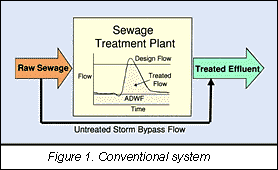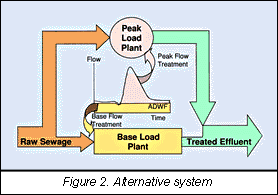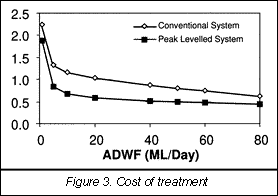Part 7: Peak load management at wastewater treatment plants

Author N.A. Booker discusses a project aimed to assess the potential of high-rate processes that can react quickly to increased flows.
By N.A. Booker, CSIRO Molecular Science
Editor's note: To follow is part seven of a nine-part series of articles written by Australia's Commonwealth Scientific and Industrial Research Organization (CSIRO), a research organization supporting Australia's industry needs. CSIRO Urban Water recently undertook a major research project designed to thoroughly investigate the nation's water supply. The series will address research results with implications for urban water supply on a global scale.
Contents
The challenge of peak flows
Technology
Cost estimates
Conclusions
Australia's water series
The challenge of peak flows
Options to cope with peak flows include:
- Impervious pipe systems – a high-cost solution with minimal chance of short-term success.
- Bypassing the treatment plant – low-cost, but untreated sewage discharges to the environment.
- Treating the peak flow – low-cost, but the biological processes are disrupted for long periods after the storm event.
- Installing oversize facilities – expensive, with underutilization of invested capital.
- Storing peak flows offline and treating them later – significant cost and aesthetic implications.
- Designing processes to deal with the peaks only, with lower capital but higher operational costs for those periods.
This project aimed to assess the potential of high-rate processes that can react quickly to increased flows, and perhaps for seasonal peak flows, for example in tourist towns. (Back to top)
Technology
Various authors have proposed processes with that potential. These include SIROFLOC (Booker & Priestley 1996), ACTIFLO (Guibelin et al. 1994), Densadeg (Delport et al. 1998), CDS (Becker et al. 2000) and high rate filtration systems (Gray et al. 1999). They all rely on chemical coagulation, flocculation and rapid separation. They have effective hydraulic loading rates 10 to 20 times faster than the 2 m3.m–2.h–1 for conventional primary sedimentation and biological processes. Consequently they have low plant size and capital costs, however, this is offset by higher operating costs due to the use of chemicals. (Back to top)
Cost Estimates
The 'conventional system' (Figure 1) is usually designed to handle a flow equivalent to three times the average dry weather flow (ADWF) and comprises: screening; primary sedimentation; extended aeration; chemical phosphorus precipitation; secondary clarification; tertiary filtration and disinfection. Annual operating costs were based on a total flow to the plant of 1.2 times the ADWF.

In the alternative approach (Figure 2), the conventional plant is designed for the base flow ADWF. A high-rate physico-chemical process runs in parallel, sized to handle two times the ADWF, but operating, say, only 10% of the time. It comprises screening, physico-chemical clarification, tertiary filtration and disinfection.

Capital costs were estimated for a range of ADWF plants under both systems, and showed that the integrated biological and physico-chemical system (Figure 2) could be constructed for less than 50% of the cost of the conventional biological plant per volume of wastewater treated. An analysis of the operating costs showed that the integrated peak flow management system would cost about 20% more to operate than the conventional system, per volume of wastewater treated.
It was assumed that capital costs could be amortized over 20 years at 5%. When this annual cost of capital was added to the annual operating cost, a cost to treat the sewage was calculated, as shown below in Figure 3. As can be seen from this data, reductions of nearly 50% in the total cost of wastewater treatment were possible through the adoption of this integrated approach. The cost data represented in Figure 3 also shows that there is an effect of system size on costs, indicating that the maximum savings were for system sizes between 10 and 40 ML/day.

(Back to top)
Conclusions
These results from the feasibility study show that there are potentially large savings in the cost of wastewater treatment through the use of physico-chemical technology to cope with peak flows. These savings could be realized at new wastewater treatment plants, or where upgrades to existing treatment facilities are proposed in order to cope with increased or seasonal hydraulic load.
It is proposed that these approaches be tested further through a demonstration study at a suitable, small sewage treatment plant. This would include:
- Full evaluation of the technical and economic merit of the proposed approaches through the use of CSIRO's design, flow and costing model.
- Assessment of the environmental outcomes of the bypass approach, compared to the construction and operation of a large plant that handles all the peak flow.
- Evaluation of existing technologies to suit the proposed applications.
- Modification or development of technology where current existing technology is shown to be inappropriate.
- Demonstration of existing and new technology options at a suitable test site.
The outcomes of this work will enable the water industry to utilize existing assets better and minimize the capital investment in new urban water infrastructure. (Back to top)
References
Becker, N.S.C., Booker, N.A, Davey, A., Gray, S.R., Jago, R. and Ritchie, C. 2000, in Chemical Water and Wastewater Treatment – V1, Proceedings of the 9th Gothenburg Symposium, October 2000 (in press).
Booker, N.A. and Priestley, A.J. 1996, in Proc. WaterTECH'96, pp. 190–197.
Delporte, C., Pujol, R. and Vion, P. 1998, http://www.degremont.fr/rd/procedes/tech7.htm.
Gray, S.R., Booker, N.A., Arld, R. and Lerch, A. 1999, in Proc. AWWA 18th Federal Convention, Adelaide, April 1999.
Guibelin, E., Delsalle, F. and Binot, P. 1994, in Chemical Water and Wastewater Treatment - I11, Proc. 6th Gothenburg Symposium, September 1994, pp. 307–316.
About the author: N.A. Booker is with CSIRO Molecular Science. For more information on CSIRO, visit their website at http://www.dbce.csiro.au. (Back)
Australia's water supply series
Part 1: An introduction to Australia's water supply
Part 2: Life cycle costing of urban water systems
Part 3: Urban Volume and Quality, a water and contaminant balance model
Part 4: TAWS: Tools for Assessing Alternative Water Systems
Part 5: The scenario manager
Part 6: Peak leveling in urban water reticulation systems
Part 7: Peak load management at wastewater treatment plants
Part 8: Economic scale of graywater reuse systems
Part 9: Septic tank replacement
(Back to top)
This article appeared in the December 2000, Number 16, edition of Innovations, a bimonthly online magazine "showcasing new technology, products and services impacting on Australia's built environment."
